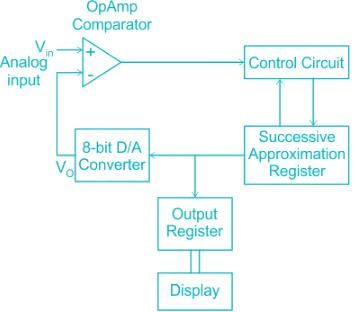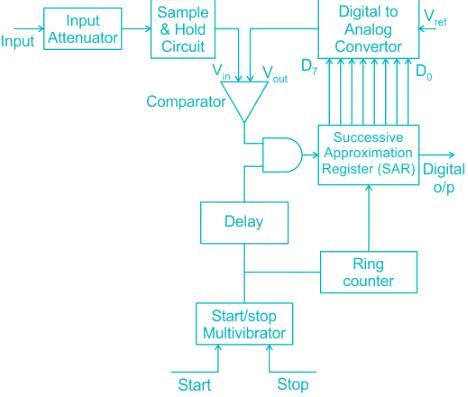Electronics and Communication Engineering (ECE) Exam > Electronics and Communication Engineering (ECE) Questions > In a successive approximation ADC:a)SAR regis...
Start Learning for Free
In a successive approximation ADC:
- a)SAR register is a shift register
- b)SAR register is simple binary up counter
- c)SAR register generates input to DAC by changing bits one by one from MSB
- d)SAR register is binary down counter
Correct answer is option 'C'. Can you explain this answer?
Verified Answer
In a successive approximation ADC:a)SAR register is a shift registerb)...
Successive Approximation type DVM:
- The successive approximation type digital voltmeter works on the principle of balancing the weights in a simple balance.
- To understand the concept clearly, let us consider whether we want to
- measure the weight of some unknown quantity of sugar.
- What do we do? First, we approximate the weight of sugar to some known weight,
- If the weight of sugar is more than the known weight, then we add some more weight to the known weight.
- If it is less, then we replace the weight with a lesser value.
- This process is repeated until the pointer balances the two weights.
- The successive approximation type DVM uses the same principle.
- A simple block diagram of SADVM is given below

An elaborated block diagram of SADVM is given below

- Consists of an input attenuator for selecting the desired range of input voltage and also to attenuate any noise in the given voltage.
- Selected input is applied to the comparator through a sample and holds circuit.
- The successive approximation register (SAR) receives its 8-bit input from the ring counter after each clock pulse.
- This input is applied to the Digital to Analog Converter (DAC) which converts the digital data into an analog voltage.
- This voltage is applied as a second input to the comparator.
- The output of the AND gate goes high when there is a positive o/p at the comparator.
- Finally, the digital output is taken out from the successive approximation register with input voltages other than dc; the input level changes during digitization, and decisions made during conversion are not consistent.
- To avoid this error, a sample and hold circuit is used and placed in the input directly following the input attenuator.
- This digital voltmeter is capable of 1000 readings per second.
Most Upvoted Answer
In a successive approximation ADC:a)SAR register is a shift registerb)...
Explanation:
Successive Approximation ADC:
Successive Approximation Register (SAR) is an important component in a Successive Approximation ADC. It is used to generate the input to the Digital-to-Analog Converter (DAC) by changing bits one by one from the Most Significant Bit (MSB) to the Least Significant Bit (LSB) in order to approximate the analog input voltage.
Function of SAR register:
The SAR register acts as a binary up counter in a Successive Approximation ADC. It starts by setting the MSB to 1 and then successively tests each bit by changing it from 1 to 0 and back to 1 based on the comparison of the DAC output with the input voltage. This process continues until all the bits have been tested and the closest digital representation of the analog input voltage is achieved.
Binary Search Algorithm:
The operation of the SAR register in a Successive Approximation ADC can be likened to a binary search algorithm. By successively changing the bits from MSB to LSB, the SAR register narrows down the possible range of the input voltage until the closest digital approximation is found. This iterative process allows for a high-speed and accurate conversion of analog signals to digital values.
Conclusion:
In summary, the SAR register in a Successive Approximation ADC is a crucial component that performs a binary search algorithm to approximate the analog input voltage. By changing bits one by one from the MSB to the LSB, the SAR register generates the input to the DAC and facilitates the conversion process with high speed and accuracy.

|
Explore Courses for Electronics and Communication Engineering (ECE) exam
|

|
Similar Electronics and Communication Engineering (ECE) Doubts
Question Description
In a successive approximation ADC:a)SAR register is a shift registerb)SAR register is simple binary up counterc)SAR register generates input to DAC by changing bits one by one from MSBd)SAR register is binary down counterCorrect answer is option 'C'. Can you explain this answer? for Electronics and Communication Engineering (ECE) 2025 is part of Electronics and Communication Engineering (ECE) preparation. The Question and answers have been prepared according to the Electronics and Communication Engineering (ECE) exam syllabus. Information about In a successive approximation ADC:a)SAR register is a shift registerb)SAR register is simple binary up counterc)SAR register generates input to DAC by changing bits one by one from MSBd)SAR register is binary down counterCorrect answer is option 'C'. Can you explain this answer? covers all topics & solutions for Electronics and Communication Engineering (ECE) 2025 Exam. Find important definitions, questions, meanings, examples, exercises and tests below for In a successive approximation ADC:a)SAR register is a shift registerb)SAR register is simple binary up counterc)SAR register generates input to DAC by changing bits one by one from MSBd)SAR register is binary down counterCorrect answer is option 'C'. Can you explain this answer?.
In a successive approximation ADC:a)SAR register is a shift registerb)SAR register is simple binary up counterc)SAR register generates input to DAC by changing bits one by one from MSBd)SAR register is binary down counterCorrect answer is option 'C'. Can you explain this answer? for Electronics and Communication Engineering (ECE) 2025 is part of Electronics and Communication Engineering (ECE) preparation. The Question and answers have been prepared according to the Electronics and Communication Engineering (ECE) exam syllabus. Information about In a successive approximation ADC:a)SAR register is a shift registerb)SAR register is simple binary up counterc)SAR register generates input to DAC by changing bits one by one from MSBd)SAR register is binary down counterCorrect answer is option 'C'. Can you explain this answer? covers all topics & solutions for Electronics and Communication Engineering (ECE) 2025 Exam. Find important definitions, questions, meanings, examples, exercises and tests below for In a successive approximation ADC:a)SAR register is a shift registerb)SAR register is simple binary up counterc)SAR register generates input to DAC by changing bits one by one from MSBd)SAR register is binary down counterCorrect answer is option 'C'. Can you explain this answer?.
Solutions for In a successive approximation ADC:a)SAR register is a shift registerb)SAR register is simple binary up counterc)SAR register generates input to DAC by changing bits one by one from MSBd)SAR register is binary down counterCorrect answer is option 'C'. Can you explain this answer? in English & in Hindi are available as part of our courses for Electronics and Communication Engineering (ECE).
Download more important topics, notes, lectures and mock test series for Electronics and Communication Engineering (ECE) Exam by signing up for free.
Here you can find the meaning of In a successive approximation ADC:a)SAR register is a shift registerb)SAR register is simple binary up counterc)SAR register generates input to DAC by changing bits one by one from MSBd)SAR register is binary down counterCorrect answer is option 'C'. Can you explain this answer? defined & explained in the simplest way possible. Besides giving the explanation of
In a successive approximation ADC:a)SAR register is a shift registerb)SAR register is simple binary up counterc)SAR register generates input to DAC by changing bits one by one from MSBd)SAR register is binary down counterCorrect answer is option 'C'. Can you explain this answer?, a detailed solution for In a successive approximation ADC:a)SAR register is a shift registerb)SAR register is simple binary up counterc)SAR register generates input to DAC by changing bits one by one from MSBd)SAR register is binary down counterCorrect answer is option 'C'. Can you explain this answer? has been provided alongside types of In a successive approximation ADC:a)SAR register is a shift registerb)SAR register is simple binary up counterc)SAR register generates input to DAC by changing bits one by one from MSBd)SAR register is binary down counterCorrect answer is option 'C'. Can you explain this answer? theory, EduRev gives you an
ample number of questions to practice In a successive approximation ADC:a)SAR register is a shift registerb)SAR register is simple binary up counterc)SAR register generates input to DAC by changing bits one by one from MSBd)SAR register is binary down counterCorrect answer is option 'C'. Can you explain this answer? tests, examples and also practice Electronics and Communication Engineering (ECE) tests.

|
Explore Courses for Electronics and Communication Engineering (ECE) exam
|

|
Signup to solve all Doubts
Signup to see your scores go up within 7 days! Learn & Practice with 1000+ FREE Notes, Videos & Tests.





























